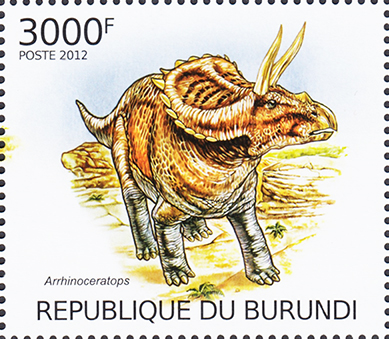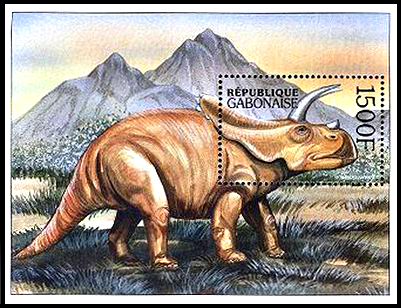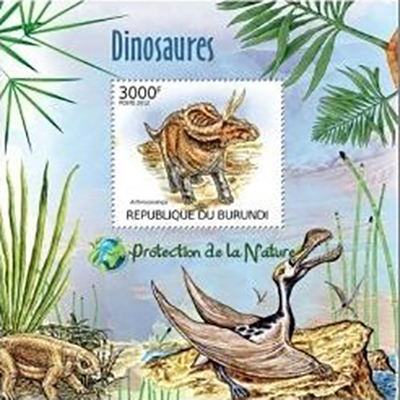Arrhinoceratops brachyops Parks, 1925

(Da: en.wikipedia.org)
Phylum: Chordata Haeckel, 1874
Subphylum: Vertebrata Cuvier, 1812
Classe: Dinosauria Owen, 1841
Ordine: Ornithischia Seeley, 1888
Famiglia: Ceratopsidae Marsh, 1890
Genere: Arrhinoceratops Parks, 1925
Descrizione
L'aspetto di questo dinosauro, esteriormente, è quasi identico a quello del più noto triceratopo. Le uniche differenze rilevanti sono la taglia minore (l'arrinoceratopo raggiungeva a malapena i 6 metri di lunghezza) e il collare più lungo. L'arrinoceratopo apparteneva ai ceratopsidi, e come gran parte delle forme appartenenti a questa famiglia aveva sviluppato due lunghe corna sopra gli occhi per difendersi dai predatori. Il collare osseo non serviva tanto per difesa, quanto per display intraspecifico o per le inserzioni dei muscoli del collo. Un ulteriore corno sul naso era talmente piccolo che, nei primi esemplari noti, non era conservato (da qui il nome "aspetto senza corno sul naso"). Il suo parente più prossimo sembrerebbe essere stato il grande Torosaurus.
Diffusione
Vissuto nel Cretaceo superiore nel Nordamerica.
Bibliografia
–"Arrhinoceratops." In: Dodson, Peter & Britt, Brooks & Carpenter, Kenneth & Forster, Catherine A. & Gillette, David D. & Norell, Mark A. & Olshevsky, George & Parrish, J. Michael & Weishampel, David B. The Age of Dinosaurs. Publications International, LTD. p. 127. ISBN 0-7853-0443-6.
–Parks, W.A. (1925). "Arrhinoceratops brachyops, a new genus and species of Ceratopsia from the Edmonton Formation of Alberta". University of Toronto Studies, Geology Series 19:1-15.
–C.W. Gilmore, 1946, "Reptilian fauna of the North Horn Formation of central Utah", United States Department of the Interior Geological Survey Professional Paper 210-C: 29-53.
–D.A. Lawson, 1976, "Tyrannosaurus and Torosaurus, Maestrichtian dinosaurs from Trans-Pecos, Texas", Journal of Paleontology 50(1): 158-164.
–Hunt, R.K. and Lehman, T.M. (2008). "Attributes of the ceratopsian dinosaur Torosaurus, and new material from the Javelina Formation (Maastrichtian) of Texas". Journal of Paleontology 82(6): 1127-1138.
–Tyson, H., 1981, "The structure and relationships of the horned dinosaur Arrhinoceratops Parks (Ornithischia: Ceratopsidae)", Canadian Journal of Earth Sciences 18: 1241-1247.
–Farke, A.A., 2007, "Cranial osteology and phylogenetic relationships of the chasmosaurine ceratopsid Torosaurus latus", pp 235-257 in: K. Carpenter (ed.), Horns and Beaks: Ceratopsian and Ornithopod Dinosaurs, Bloomington, Indiana University Press.
–Paul, G.S., 2010, The Princeton Field Guide to Dinosaurs, Princeton University Press p. 267.
–R.S. Lull, 1933, "A revision of the Ceratopsia or horned dinosaurs", Memoirs of the Peabody Museum of Natural History 3(3): 1-175
–L.S. Russell, 1930, "Upper Cretaceous dinosaur faunas of North America", Proceedings of the American Philosophical Society 69(4): 133-159.
–P. Dodson and P.J. Currie, 1990, "Neoceratopsia". In: D.B. Weishampel, H. Osmolska, and P. Dodson (eds.), The Dinosauria. First Edition. University of California Press, Berkeley, pp 593-618.
–Scott D. Sampson; Mark A. Loewen; Andrew A. Farke; Eric M. Roberts; Catherine A. Forster; Joshua A. Smith & Alan L. Titus (2010). Stepanova, Anna (ed.). "New Horned Dinosaurs from Utah Provide Evidence for Intracontinental Dinosaur Endemism".

|
Data: 31/08/2012
Emissione: Animali preistorici Stato: Burundi Nota: Emesso in un foglietto di 4 v. diversi |
|---|

|
Data: 20/12/2000
Emissione: Animali preistorici Stato: Gabon |
|---|

|
Data: 31/08/2012
Emissione: Animali preistorici Stato: Burundi |
|---|